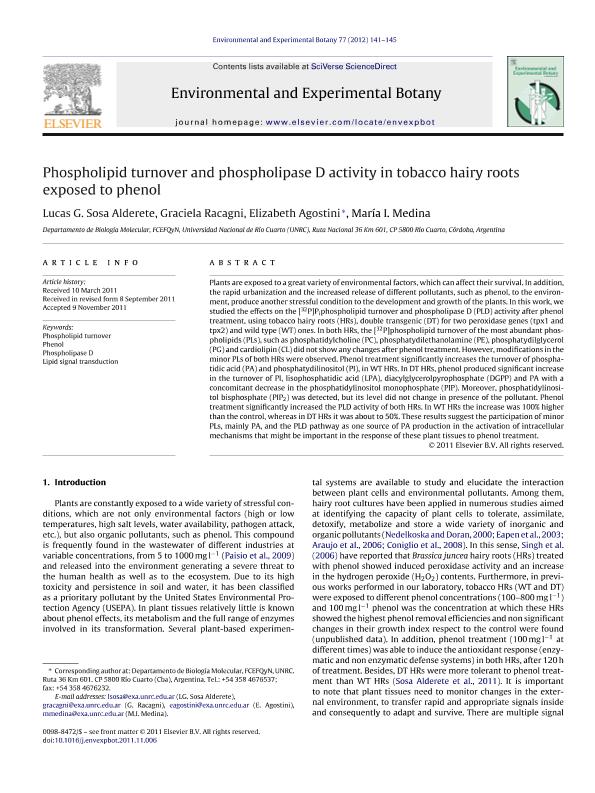Mostrar el registro sencillo del ítem
dc.contributor.author
Sosa Alderete, Lucas Gastón

dc.contributor.author
Racagni, Graciela Esther

dc.contributor.author
Agostini, Elizabeth

dc.contributor.author
Medina, María I.
dc.date.available
2024-03-13T14:05:04Z
dc.date.issued
2012-04
dc.identifier.citation
Sosa Alderete, Lucas Gastón; Racagni, Graciela Esther; Agostini, Elizabeth; Medina, María I.; Phospholipid turnover and phospholipase D activity in tobacco hairy roots exposed to phenol; Pergamon-Elsevier Science Ltd; Environmental and Experimental Botany; 77; 4-2012; 141-145
dc.identifier.issn
0098-8472
dc.identifier.uri
http://hdl.handle.net/11336/230401
dc.description.abstract
Plants are exposed to a great variety of environmental factors, which can affect their survival. In addition, the rapid urbanization and the increased release of different pollutants, such as phenol, to the environment, produce another stressful condition to the development and growth of the plants. In this work, we studied the effects on the [32P]Piphospholipid turnover and phospholipase D (PLD) activity after phenol treatment, using tobacco hairy roots (HRs), double transgenic (DT) for two peroxidase genes (tpx1 and tpx2) and wild type (WT) ones. In both HRs, the [32P]phospholipid turnover of the most abundant phospholipids (PLs), such as phosphatidylcholine (PC), phosphatydilethanolamine (PE), phosphatydilglycerol (PG) and cardiolipin (CL) did not show any changes after phenol treatment. However, modifications in the minor PLs of both HRs were observed. Phenol treatment significantly increases the turnover of phosphatidic acid (PA) and phosphatydilinositol (PI), in WT HRs. In DT HRs, phenol produced significant increase in the turnover of PI, lisophosphatidic acid (LPA), diacylglycerolpyrophosphate (DGPP) and PA with a concomitant decrease in the phosphatidylinositol monophosphate (PIP). Moreover, phosphatidylinositol bisphosphate (PIP2) was detected, but its level did not change in presence of the pollutant. Phenol treatment significantly increased the PLD activity of both HRs. In WT HRs the increase was 100% higher than the control, whereas in DT HRs it was about to 50%. These results suggest the participation of minor PLs, mainly PA, and the PLD pathway as one source of PA production in the activation of intracellular mechanisms that might be important in the response of these plant tissues to phenol treatment.32P]Piphospholipid turnover and phospholipase D (PLD) activity after phenol treatment, using tobacco hairy roots (HRs), double transgenic (DT) for two peroxidase genes (tpx1 and tpx2) and wild type (WT) ones. In both HRs, the [32P]phospholipid turnover of the most abundant phospholipids (PLs), such as phosphatidylcholine (PC), phosphatydilethanolamine (PE), phosphatydilglycerol (PG) and cardiolipin (CL) did not show any changes after phenol treatment. However, modifications in the minor PLs of both HRs were observed. Phenol treatment significantly increases the turnover of phosphatidic acid (PA) and phosphatydilinositol (PI), in WT HRs. In DT HRs, phenol produced significant increase in the turnover of PI, lisophosphatidic acid (LPA), diacylglycerolpyrophosphate (DGPP) and PA with a concomitant decrease in the phosphatidylinositol monophosphate (PIP). Moreover, phosphatidylinositol bisphosphate (PIP2) was detected, but its level did not change in presence of the pollutant. Phenol treatment significantly increased the PLD activity of both HRs. In WT HRs the increase was 100% higher than the control, whereas in DT HRs it was about to 50%. These results suggest the participation of minor PLs, mainly PA, and the PLD pathway as one source of PA production in the activation of intracellular mechanisms that might be important in the response of these plant tissues to phenol treatment.32P]phospholipid turnover of the most abundant phospholipids (PLs), such as phosphatidylcholine (PC), phosphatydilethanolamine (PE), phosphatydilglycerol (PG) and cardiolipin (CL) did not show any changes after phenol treatment. However, modifications in the minor PLs of both HRs were observed. Phenol treatment significantly increases the turnover of phosphatidic acid (PA) and phosphatydilinositol (PI), in WT HRs. In DT HRs, phenol produced significant increase in the turnover of PI, lisophosphatidic acid (LPA), diacylglycerolpyrophosphate (DGPP) and PA with a concomitant decrease in the phosphatidylinositol monophosphate (PIP). Moreover, phosphatidylinositol bisphosphate (PIP2) was detected, but its level did not change in presence of the pollutant. Phenol treatment significantly increased the PLD activity of both HRs. In WT HRs the increase was 100% higher than the control, whereas in DT HRs it was about to 50%. These results suggest the participation of minor PLs, mainly PA, and the PLD pathway as one source of PA production in the activation of intracellular mechanisms that might be important in the response of these plant tissues to phenol treatment.2) was detected, but its level did not change in presence of the pollutant. Phenol treatment significantly increased the PLD activity of both HRs. In WT HRs the increase was 100% higher than the control, whereas in DT HRs it was about to 50%. These results suggest the participation of minor PLs, mainly PA, and the PLD pathway as one source of PA production in the activation of intracellular mechanisms that might be important in the response of these plant tissues to phenol treatment.
dc.format
application/pdf
dc.language.iso
eng
dc.publisher
Pergamon-Elsevier Science Ltd

dc.rights
info:eu-repo/semantics/openAccess
dc.rights.uri
https://creativecommons.org/licenses/by-nc-sa/2.5/ar/
dc.subject
PHENOL
dc.subject
PLD
dc.subject
PHOSPHOLIPIDS
dc.subject
SIGNAL TRANSDUCTION
dc.subject.classification
Biotecnología Medioambiental

dc.subject.classification
Biotecnología del Medio Ambiente

dc.subject.classification
INGENIERÍAS Y TECNOLOGÍAS

dc.title
Phospholipid turnover and phospholipase D activity in tobacco hairy roots exposed to phenol
dc.type
info:eu-repo/semantics/article
dc.type
info:ar-repo/semantics/artículo
dc.type
info:eu-repo/semantics/publishedVersion
dc.date.updated
2024-03-05T13:23:44Z
dc.identifier.eissn
1873-7307
dc.journal.volume
77
dc.journal.pagination
141-145
dc.journal.pais
Estados Unidos

dc.journal.ciudad
Amsterdam
dc.description.fil
Fil: Sosa Alderete, Lucas Gastón. Universidad Nacional de Río Cuarto. Facultad de Ciencias Exactas Fisicoquímicas y Naturales. Instituto de Biotecnología Ambiental y Salud - Consejo Nacional de Investigaciones Científicas y Técnicas. Centro Científico Tecnológico Conicet - Córdoba. Instituto de Biotecnología Ambiental y Salud; Argentina
dc.description.fil
Fil: Racagni, Graciela Esther. Universidad Nacional de Río Cuarto. Facultad de Ciencias Exactas Fisicoquímicas y Naturales; Argentina
dc.description.fil
Fil: Agostini, Elizabeth. Universidad Nacional de Río Cuarto. Facultad de Ciencias Exactas Fisicoquímicas y Naturales. Instituto de Biotecnología Ambiental y Salud - Consejo Nacional de Investigaciones Científicas y Técnicas. Centro Científico Tecnológico Conicet - Córdoba. Instituto de Biotecnología Ambiental y Salud; Argentina
dc.description.fil
Fil: Medina, María I.. Universidad Nacional de Río Cuarto. Facultad de Ciencias Exactas Fisicoquímicas y Naturales; Argentina
dc.journal.title
Environmental and Experimental Botany

dc.relation.alternativeid
info:eu-repo/semantics/altIdentifier/doi/https://doi.org/10.1016/j.envexpbot.2011.11.006
dc.relation.alternativeid
info:eu-repo/semantics/altIdentifier/url/https://www.sciencedirect.com/science/article/pii/S0098847211002826
Archivos asociados
